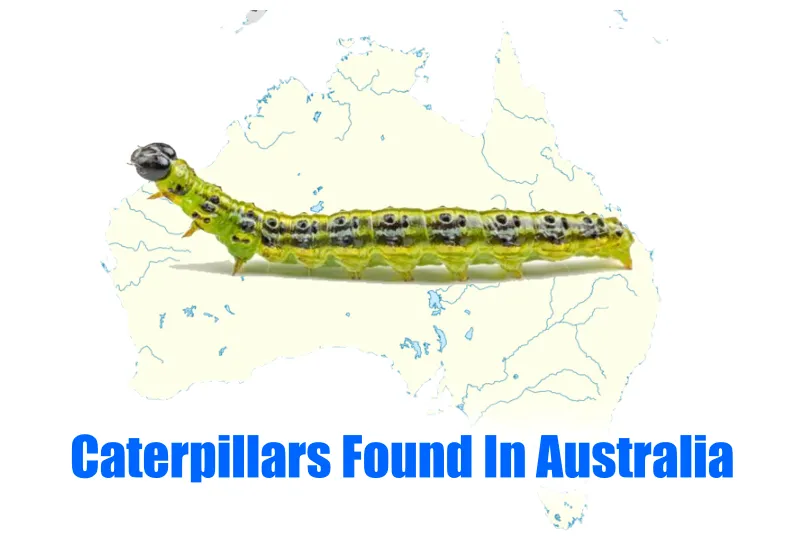Australia has always been a fascinating site for zoologists due to its incredible fauna, from marsupials to insects. Not only are kangaroos famous there, but they are also famous for their butterflies.
When we think about butterflies, we often overlook caterpillars, which are just as beautiful as butterflies. So here in this article, we will discuss 15 extraordinary caterpillars found in Australia. So let’s get started.
15 Caterpillars found in Australia
1) Australian Grapevine Moth Caterpillar
| Scientific name | Phalaenoides glycinae |
| Size (Wingspan) | up to 5 cm |
| Geographic location | Southeastern Australia |
| Identification | Have black and yellow lines all across the body |
2) Coprosma Hawk moth caterpillar
| Scientific name | Hippotion scrofa |
| Size (Wingspan) | up to 7 cm |
| Geographic location | Australia, New Caledonia and Vanuatu |
| Identification | Have Black caterpillar with yellow spots and stripes |
When you look at the freshly emerged larvae, they look pale green in color with a black horn that is paler at the tip.
These omnivorous caterpillars subsequently acquire eyespots on their abdominal segments.
The head and thorax regions are smaller and narrower than the abdomen.
In the last phases, right before pupation, they turn blackish brown with yellow dots and stripes. Their adults also have a reddish underside, which gives them an alluring appearance.
3) Orchard Swallowtail butterfly caterpillar
| Scientific name | Papilio aegeus |
| Size | 102 to 108 mm |
| Geographic location | Eastern Australia |
| Identification | Green larva with irregular white and yellow markings |
Palilio aegeus, or orchard swallowtail butterfly, is named after the ancient Greek king Aegeus.
The mature larvae of this orchard swallowtail butterfly are yellowish-green with irregular white and yellow markings.
They are well-known pests of suburban lemon grass.
They are one of Australia’s biggest and most intriguing butterflies. Its caterpillars are extraordinary, with black and white spines that protect them from predators.
4) Cairns Birdwing butterfly caterpillar
| Scientific name | Ornithoptera euphorion |
| Size (Wingspan) | up to 18 cm |
| Geographic location | Queensland |
| Identification | Caterpillars have large orange spines with black tips |
The caterpillar of this Cairns birdwing butterfly is so intriguing that it will make you astonished by their appearance.
These caterpillars are dark brown in hue, with orange spines with black ends and a yellow fifth spine.
The female of this species is so stupid that she lays eggs in an elegant Dutchman’s pipe, an Australian vine, but the larvae perish due to the poison they contain.
5) Mottled Cup Moth caterpillar
| Scientific name | Doratifera vulnerans |
| Size (Wingspan) | 2 cm to 5 cm |
| Geographic location | Queensland, New South Wales, Victoria, and Western Australia |
| Identification | Caterpillar have four knobs on each side |
The next caterpillar we have on our list is the mottled cup moth caterpillar, which is commonly found in Queensland, New South Wales, Victoria, and Western Australia.
This species exhibits aposematism; they appear so threatening that no one will approach them.
These caterpillars have characteristic four knobs on each side and a pair of yellow and green saddle-like marks on the back.
These knobs contain stinging hairs that have the ability to sting.
6) White Cabbage moth caterpillar
| Scientific name | Pieris rapae |
| Size (Wingspan) | 32–47 mm |
| Geographic location | Melbourne, Sydney |
| Identification | caterpillars are blue-green in color with black spots |
Cabbageworms have long been a source of concern for farmers. Perhaps you have come upon them as well.
These larvae have five legs and are velvety blue-green in hue with black spots.
To become pupae, they had to go through five steps. On each side, a broken yellow line can also be observed.
7) Tailed Emperor butterfly caterpillar
| Scientific name | Polyura sempronius |
| Size (Wingspan) | 75 to 85 mm |
| Geographic location | Southern New South Wales, Victoria, and eastern South Australia |
| Identification | Have a yellow line (crescents) on each side |
During this stage of life, the caterpillar of this tailed emperor butterfly changes appearance several times.
In the juvenile stage, they are yellow in color with a black head. Later, not only their color but also four horns appear on their heads.
In the last stages, they become green in color, with a lot of yellow crescents present on each side.
They can attain a length of 8 cm. During pupation, they use their cremaster or hooks to grip the stem of their feeding plant.
8) Painted Vine Moth caterpillar
| Scientific name | Agarista agricola |
| Size (Wingspan) | 50 mm |
| Geographic location | Brisbane area, Queensland, Australia |
| Identification | Caterpillars have white and black alternative bands and a few orange bands in between |
White and black alternative bands, with some orange bands in between, make this caterpillar species intriguing.
They also have black antennae pairs all over the body.
Before pupation, they used to chew bark and break it into small pieces, in which they cocooned themselves.
They feed on various plants like Australian Native Grape, Slender Grape, Cultivated Grape, etc. These caterpillars can grow up to 7 cm.
9) Black Jezebel butterfly caterpillar
| Scientific name | Delias nigrina |
| Size (Wingspan) | 56 mm |
| Geographic location | eastern seaboard of Australia, from Queensland through New South Wales to Victoria |
| Identification | Caterpillars are yellow-brown with white spiny feathers |
With yellow, white, and red margins on the wings, these black Jezebel butterflies come on the list of the most beautiful butterflies.
Not only these adults, but their larvae are also fascinating.
Males and females show a clear-cut distinction in terms of appearance.
One spot these creatures on the eastern seaboard of Australia, from Queensland through New South Wales to Victoria on mistletoes.
10) Citrus Swallowtail butterfly caterpillar
| Scientific name | Papilio demodocus |
| Size (Wingspan) | 80 to 100 mm |
| Geographic location | Southern Australia |
| Identification | have an orange-colored organ called osmeterium |
Citrus swallowtail or Christmas butterfly are some of the common names of Papilio demodocus.
They got the common name citrus swallowtail as they lay eggs on the citrus leaves.
In the juvenile stage, larvae resemble the bird’s waste in order to protect themselves from predators. In later stages, they can maximally reach a length of up to 45 mm.
In their mature state, they contain osmeterium, which is a characteristic feature of Papilionidae family larvae.
These forked structures usually secrete a foul smell, which doesn’t let predators come near them.
11) Coequosa australasiae caterpillar
| Scientific name | Coequosa australasiae |
| Size (Wingspan) | up to 120 mm |
| Geographic location | New South Wales, the Northern Territory, Queensland and Victoria |
| Identification | Caterpillars have thin spines on their abdomen |
Males of this moth species have tufts of orange hair called coremata to attract females, which is a characteristic feature of this species.
The length of 11 cm and green coloration with small warts make these larvae distinctive from other species.
Yellow diagonal lines are also found on their abdomen.
One can easily spot them in New South Wales, the northern territory, Queensland, and Victoria, feeding on the foliage of gum trees like Sydney blue gum, etc.
12) Batwing moth caterpillar
| Scientific name | Chelepteryx collesi |
| Size | 140 to 160 mm |
| Geographic location | Australasia |
| Identification | Have tufts of long, stiff, reddish hairs |
Have you ever seen a caterpillar with a spine all over the body? No, then meet this batwing moth caterpillar.
These batwing moth larvae have tufts of long, stiff reddish hairs all across their bodies, which protect them from their potential predators.
They are one of the largest Australian caterpillars that can reach a length of up to 12 cm.
Not only are they dangerous to their predators, but also to the people who climb gum trees. They are commonly found in Australasia.
13) Australian painted lady caterpillar
| Scientific name | Vanessa kershawi |
| Size | 43 to 47mm |
| Geographic location | Southern Australia |
| Identification | Have different yellow patterns, like dots and stripes, all over the body |
Another spiny caterpillar we have on our list is the Australian-painted lady caterpillar.
These caterpillars are nocturnal and spend the day hiding under tree leaves.
These caterpillars are brown in color with different yellow patterns present all over the body, and branched spines are also present.
They may be found on daisy family plants such as strawflower and rice flower.
14) Saunders’ case moth caterpillar
| Scientific name | Metura elongatus |
| Size (Wingspan) | up to 30 mm |
| Geographic location | Eastern Australia |
| Identification | Silk Shelter is present |
Ever imagined a caterpillar who always bears a mobile silk case all the time you see them? no right, but they really exist.
These Saunders’ case moth caterpillars are black and orange in color with a silk shelter that is covered with leaves and twigs.
This silk shelter not only aids in protection but also helps them climb even on glass surfaces.
In the later stages, larvae pupate themselves in these cases. Also, wingless females are present in this species.
15) Gum-leaf Skeletoniser caterpillar
| Scientific name | Uraba lugens |
| Size | 25 to 30 mm |
| Geographic location | temperate, subtropical, and tropical Australia |
| Identification | Have previous molted skin hat |
The gum leaf skeletonizer caterpillars are also known as mad hatter pillars, and the unicorn caterpillars are named due to their unique exoskeleton.
Earlier molted skin gets accumulated in their head region, which gives it a hat appearance.
They are all covered with spines or white setae, which can even lead to an anaphylactic reaction in humans if they come into contact with them.
Conclusion
Here we conclude our article on 15 uncommon caterpillars found in Australia.
Australia is full of unseen surprises, and one of them we just saw.
These caterpillars have adapted so beautifully that they have been amazing to us for a long time.
I hope you like reading about these creatures. We will be back with another article soon.
References
Wikipedia, https://www.butterflyhouse.com.au/
Also Read:

Being a zoology student I’m always been fascinated toward animals especially insects. I love to do research and learn about different animals. As a writer I want to share my thoughts about nature through my articles. Apart from this you can find me exploring the new places and voice notes.
